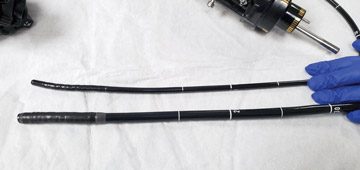Ultrathin endoscopes have proven to be invaluable instruments for examining the upper GI tract of patients with challenging anatomy, even if that wasn't their intended application. "Upper endoscopy exams performed with a standard endoscope passed through the mouth require sedating the patient, and ultrathin scopes were originally designed to facilitate sedationless upper endoscopies with the transnasal approach," says Vivek Kaul, MD, FACG, FASGE, AGAF, a professor of medicine at the University of Rochester (N.Y.) Medical Center & Strong Memorial Hospital. "But the method has failed to catch on, perhaps because patients have expectations to receive sedation and anesthesia when undergoing exams."
The push for transnasal endoscopy was intended to mitigate risks related to sedation and anesthesia, which account for a majority of complications that occur during upper endoscopy procedures. "Sedationless exams are also easier for patients, who undergo the procedures and can drive themselves home or to work as soon as it ends."
It's a great concept, at least in theory. Douglas Adler, MD, FACG, AGAF, FASGE, says more practical applications of ultrathin scopes involve maneuvering around complex strictures and post-surgical anatomy in upper GI tracts or use in pediatric patients who can't tolerate an adult scope.
Dr. Adler, a professor of medicine at the University of Utah School of Medicine and Huntsman Cancer Center in Salt Lake City, believes the primary benefit of ultrathin scopes is that they can be used in office-based settings. "But very few gastroenterologists perform office-based endoscopy procedures because they're used to performing a complete upper examination, which includes the esophagus, stomach and the beginning segment of the small bowel," he says.
Enhanced imaging helps physicians identify lesions, better characterize the mucosal lining and facilitate mapping of abnormal anatomy.
— Vivek Kaul, MD, FACG, FASGE, AGAF
Most in-office sedationless exams include the esophagus and perhaps the beginning portion of the stomach due to patient tolerance, according to Dr. Adler. "Culturally, physicians feel like esophageal screening procedures are incomplete exams," he says. "What if they miss a stomach ulcer they would have seen with a standard endoscope?"
.svg?sfvrsn=be606e78_3)

.svg?sfvrsn=56b2f850_5)